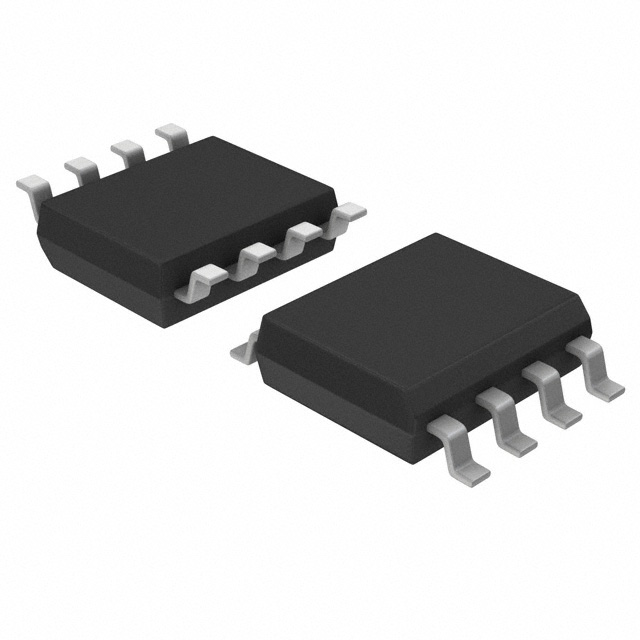PCA9517AD,112
Product Overview
Category: Integrated Circuit (IC)
Use: Level shifting and translating between different voltage levels in I2C bus applications.
Characteristics: - Bidirectional voltage level translator - Supports I2C Fast Mode Plus (Fm+) with speeds up to 1 MHz - Provides bidirectional buffering for SDA and SCL lines - Compatible with both 3.3V and 5V systems - Allows voltage translation between two different supply voltages - Supports hot insertion - Low standby current consumption
Package: SOIC (Small Outline Integrated Circuit)
Essence: The PCA9517AD,112 is an IC that enables voltage level shifting and translation in I2C bus applications, allowing communication between devices operating at different voltage levels.
Packaging/Quantity: The PCA9517AD,112 is available in a standard SOIC package. It is typically sold in reels or tubes containing multiple units.
Specifications
- Supply Voltage Range: 2.3V to 5.5V
- Operating Temperature Range: -40°C to +85°C
- Maximum Data Rate: 1 MHz
- Standby Current: 10 µA (typical)
- Package Type: SOIC-8
Pin Configuration
The PCA9517AD,112 has the following pin configuration:
___________
SDA | 1 8 | VCC
SCL | 2 7 | OE#
GND | 3 6 | SDAOUT
SDAIN | 4 5 | SCLIN
|__________|
Functional Features
- Bidirectional voltage level shifting: Allows communication between devices operating at different voltage levels.
- Bidirectional buffering: Provides buffering for both SDA and SCL lines, ensuring proper signal integrity.
- Hot insertion support: Allows the device to be inserted or removed from an active I2C bus without causing disruption.
- Compatibility with 3.3V and 5V systems: Can be used in systems operating at either voltage level.
Advantages and Disadvantages
Advantages: - Supports high-speed data transfer up to 1 MHz. - Low standby current consumption helps conserve power. - Compatible with a wide range of supply voltages. - Enables communication between devices with different voltage requirements.
Disadvantages: - Limited to I2C bus applications and may not be suitable for other communication protocols. - Requires careful consideration of voltage levels and compatibility to avoid potential issues.
Working Principles
The PCA9517AD,112 operates by monitoring the voltage levels on the SDAIN and SCLIN pins and translating them to the corresponding voltage levels on the SDAOUT and SCLOUT pins. It uses internal circuitry to ensure bidirectional voltage translation while maintaining signal integrity.
Detailed Application Field Plans
The PCA9517AD,112 can be used in various applications where voltage level shifting is required in I2C bus communication. Some potential application fields include:
- Embedded Systems: Enable communication between microcontrollers operating at different voltage levels.
- Industrial Automation: Facilitate communication between sensors, actuators, and control systems with varying voltage requirements.
- Consumer Electronics: Connect devices such as smartphones, tablets, and displays that operate at different voltage levels.
- Automotive Electronics: Support communication between different modules and subsystems within a vehicle.
Detailed and Complete Alternative Models
- PCA9306: Similar bidirectional I2C bus voltage level translator with automatic direction sensing.
- TXB0108: Eight-channel bidirectional voltage-level translator with automatic direction sensing.
- BSS138: Single-channel bidirectional voltage-level translator for I2C and other applications.
These alternative models offer similar functionality to the PCA9517AD,112 and can be considered as alternatives based on specific requirements and constraints.
Word count: 511 words
10个与PCA9517AD,112在技术解决方案中的应用相关的常见问题及解答
Sure! Here are 10 common questions and answers related to the application of PCA9517AD,112 in technical solutions:
Q: What is PCA9517AD,112?
A: PCA9517AD,112 is a level-translating I2C-bus repeater that provides bidirectional voltage-level translation between low-voltage (down to 0.9V) and higher-voltage (up to 5.5V) I2C-bus or SMBus applications.Q: What is the purpose of using PCA9517AD,112 in a technical solution?
A: PCA9517AD,112 is used to enable communication between devices operating at different voltage levels on an I2C bus, ensuring compatibility and reliable data transfer.Q: Can PCA9517AD,112 be used for level shifting in both directions?
A: Yes, PCA9517AD,112 supports bidirectional level shifting, allowing communication between devices with different voltage levels in both directions.Q: What is the maximum voltage difference that PCA9517AD,112 can handle?
A: PCA9517AD,112 can handle a maximum voltage difference of 4.6V between the low-voltage side and the high-voltage side.Q: How many devices can be connected to PCA9517AD,112?
A: PCA9517AD,112 can support up to 8 devices connected to the I2C bus, including the master device.Q: Does PCA9517AD,112 require external power supply?
A: Yes, PCA9517AD,112 requires an external power supply connected to its VCC pin to operate.Q: What is the maximum operating frequency of PCA9517AD,112?
A: PCA9517AD,112 can operate at a maximum frequency of 400 kHz, making it suitable for high-speed I2C applications.Q: Can PCA9517AD,112 be used in a multi-master I2C system?
A: Yes, PCA9517AD,112 supports multi-master systems and allows multiple devices to communicate on the I2C bus.Q: Does PCA9517AD,112 have any built-in protection features?
A: Yes, PCA9517AD,112 has built-in ESD protection on its I/O pins, providing robustness against electrostatic discharge events.Q: Are there any application notes or reference designs available for PCA9517AD,112?
A: Yes, NXP provides application notes and reference designs that can help in understanding and implementing PCA9517AD,112 in various technical solutions.


